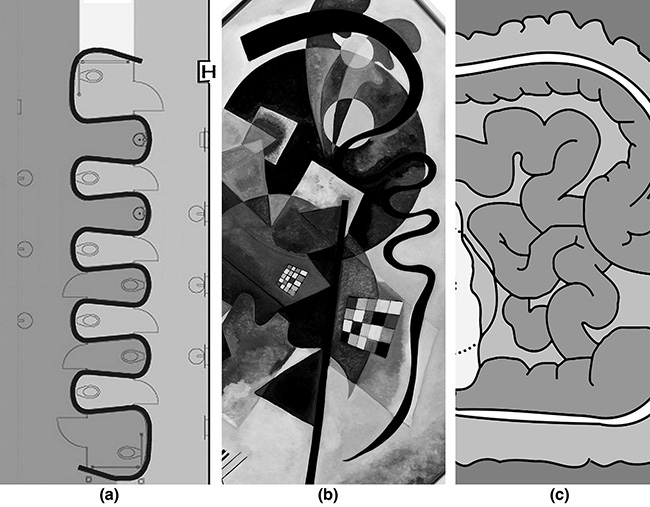contact | contents | bibliography | illustration credits | ⇦ chapter 20 |
21. WATER EFFICIENCY
Water Efficient Landscaping
Credits 1.1 and 1.2. The intention of these credits is to discourage the use of landscape irrigation, either by planting things which don't require added water (i.e., native or adapted species that survive using whatever falls from the sky); or by collecting—harvesting—rainwater or using cleaned-up wastewater (or graywater) to irrigate plants that otherwise would not survive in the environment in which they are planted. This is not hard to accomplish in the northeastern part of the U.S., which enjoys a temperate climate with adequate quantities of rain to sustain a varied assortment of planted things. In the case of Milstein Hall, the major planted element is a vegetated (green) roof, which consists of sedums— an adapted species of succulent plants that do well in the shallow engineered media characteristic of extensive green roofs.
Now, if lots of things grow in this region without irrigation anyway, why does planting a green roof count as "water-efficient"? In Los Angeles, it might be reasonable to recognize building projects that eschew turf grass and other rain-loving species, but should a New York State building be promoted as "green" just because its plantings need no irrigation? LEED answers this question by granting two points for Milstein Hall.
Innovative Wastewater Technology
Credit 2. This credit is designed to discourage use of potable water to wash away human waste. There are two benefits: less potable water is used, so that either less infrastructure is needed to produce and transport the potable water, or potable water can be diverted to other industrial or agricultural purposes; and less infrastructure for wastewater treatment is needed. Rather than investing in this type of sustainable activity, the architects for, and owners of, Milstein Hall instead have chosen to design and build an expensive architectural joke whose subject could be construed to be human waste: the toilets and urinals for Milstein Hall are defined by a curving stainless steel wall reminiscent of certain paintings by Wassily Kandinsky or, more to the point, the interlocking geometry of the small intestine (fig. 21.1).

Figure 21.1. Toilets and urinals for Milstein Hall are defined by a curving stainless steel wall (a) reminiscent of the paintings of Wassily Kandinsky (b), or the interlocking geometry of the small intestine (c).
This illustrates in a concise manner the priorities for this building and for this type of architecture: like Kandinsky's painting, the concerns are almost entirely visual and expressive. But unlike Kandinsky's painting, which by its nature can only be visual and expressive, works of architecture are also, and primarily, utilitarian constructions. Milstein Hall prioritizes artistry and irony while sacrificing sustainability.
Water Use Reduction
Credits 3.1 and 3.2. This is the third leg of LEED's three-legged water-use stool. Aside from irrigation and wastewater reduction (Credits 1 and 2), one can also reduce the use of potable water by installing high-efficiency toilets, urinals, or showers (i.e., using fixtures that use less water per flush or that reduce the flow of water) or by reusing stormwater or graywater for flushing (so that potable water does not need to be used for this purpose) or by using sensors or similar devices on faucets (so that the quantity of water coming out of faucets is controlled). One point is gained by reducing the 1992 Energy Policy Act performance requirements by 20 percent. Two points are awarded for a 30 percent reduction. Milstein Hall gains these points presumably by purchasing high-efficiency toilets and urinals, and by installing sensors on lavatory faucets. There is no attempt to harvest and reuse rainwater that falls on the vegetated roof.
The Energy Policy Act, a federal law that mandates low-flow showerheads and water-efficient toilets and urinals, does not exist in a political vacuum. In fact, it has aroused the ire of many free-market conservatives, libertarians, as well as representatives from water-rich states. U.S. Senator Rand Paul delivered the classic rant against governmental regulation in general and low-flow toilets in particular, castigating the deputy secretary for energy efficiency at a hearing in 2011: "Frankly, the toilets don't work in my house," he said. "And I blame you, and people like you who want to tell me what I can install in my house, what I can do."1 Paul accused the deputy secretary of hypocrisy because, even though she and others in the Obama administration were presumably "pro-choice" on the issue of abortion, they challenged his God-given right to squander environmental resources.
Notes
1 Chris Good, "Rand Paul and the 19-Year Libertarian War on Low-Flow Toilets," Atlantic (March 16, 2011) here.
contact | contents | bibliography | illustration credits | ⇦ chapter 20 |

